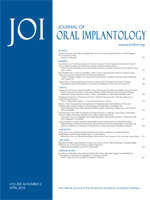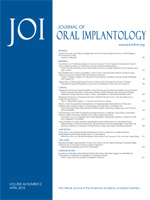
Journal of Oral Implantology Volume 47 Issue 4
Authors of a recent study in the Journal of Oral Implantology evaluated patient outcomes after using 2 dental transplant materials, namely, (i) a resorbable collage membrane and (ii) the newer autogenous membrane derived from the patient’s blood called platelet-rich fibrin (PRF).
LAWRENCE, Kan. (PRWEB)
September 21, 2021
Journal of Oral Implantology – Oral rehabilitation and dental implants have been used for years to restore functionality and esthetics after tooth loss or extraction. Specifically, implant success has improved because of the development of materials added to surgical sites when a tooth is removed. These materials help guide bone regeneration and decrease the risk of infection. Authors of a recent study in the Journal of Oral Implantology evaluated patient outcomes after using 2 dental transplant materials, namely, (i) a resorbable collage membrane and (ii) the newer autogenous membrane derived from the patient’s blood called platelet-rich fibrin (PRF).
Researchers and clinicians from Mansoura University and McGill University selected 14 patients who needed a tooth extraction and a dental implant. Demographic and clinical information was gathered regarding patient profiles and a detailed examination with radiographs was performed to evaluate implant placement. Patients were divided into 2 groups that were treated identically except for the type of membrane used; a resorbable collage membrane or the PRF membrane. The authors detailed their surgery techniques and the postoperative instructions provided to the patients. Patient outcomes were assessed at baseline, 6 and 12 months following surgery. Overall, the surgeries were successful, with no implant failures.
Specifically, there were no differences in implant stability or values indicative of inflammation and infection (ie, modified sulcus bleeding index and peri-implant pocket depth [PPD]) between the 2 techniques. They did find some significant differences in implant stability and PPD over time that were deemed as a possible result of the surgery techniques used.
The authors also described previous research to highlight the benefits of using PRF. PRF contains white blood cells that limit infection and continuously releases growth factors from platelets that promote the healing process. Additionally, PRF reduces the risk of membrane reactions because it is derived from a patient’s own blood, and is cost-effective to generate. The authors also discuss that the resorbable collagen membrane may contribute to positive outcomes after implant placement because it attracts growth factors to the wound site, thus supporting regeneration at the surgical site.
Finally, the authors emphasize the advantages of placing implants immediately after tooth extraction and bone grafting, rather than delaying implant placement following hard and soft tissue healing. Immediate implants not only avoid the bone loss that occurs after tooth extraction but also decrease the necessity of multiple surgeries and thus decrease treatment costs.
Although the authors point out that a long-term clinical trial should be performed to confirm these findings, their results show that using the new PRF provides excellent results.
Full text of the article “Efficacy of Autogenous Platelet-Rich Fibrin Versus Slowly Resorbable Collagen Membrane With Immediate Implants in the Esthetic Zone,” Journal of Oral Implantology, is available at https://doi.org/10.1563/aaid-joi-D-20-00124.
###
About the Journal of Oral Implantology
The Journal of Oral Implantology is the official publication of the American Academy of Implant Dentistry and of the American Academy of Implant Prosthodontics. It is dedicated to providing valuable information to general dentists, oral surgeons, prosthodontists, periodontists, scientists, clinicians, laboratory owners and technicians, manufacturers, and educators. The JOI distinguishes itself as the first and oldest journal in the world devoted exclusively to implant dentistry. For more information about the journal or the society, please visit http://www.joionline.org
Share article on social media or email:

